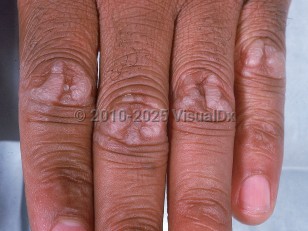Focal acral hyperkeratosis
Alerts and Notices
Important News & Links
Synopsis

Focal acral hyperkeratosis (FAH) is a rare and benign cutaneous disorder characterized by clusters of discrete, small, firm, hyperkeratotic papules along the borders of the hands and feet. The exact etiology and pathogenesis are not known. Most cases are sporadic, although familial cases have also been described, with the mode of inheritance being autosomal dominant with incomplete penetrance. There is no established racial or sex predilection, and individuals of any age can be affected.
Onset is gradual and typically occurs during childhood and adolescence, with the vast majority of cases developing before the age of 20 years. FAH usually progresses with advancing age (increased number and size of hyperkeratotic papules). Although asymptomatic, patients often present with concerns about cosmetic appearance. Multiple treatment modalities have been attempted without much success.
Clinically, FAH is identical to acrokeratoelastoidosis (AKE). The major difference between these two disorders is the histopathologic finding of elastorrhexis (fragmentation and degeneration of elastic fibers) in the dermis, a feature that is present in AKE but absent in FAH. In addition, hyperhidrosis is rarely associated with AKE but not FAH. It is still controversial whether FAH is a distinct entity or a variant of AKE.
Related topic: Punctate palmoplantar keratoderma
Onset is gradual and typically occurs during childhood and adolescence, with the vast majority of cases developing before the age of 20 years. FAH usually progresses with advancing age (increased number and size of hyperkeratotic papules). Although asymptomatic, patients often present with concerns about cosmetic appearance. Multiple treatment modalities have been attempted without much success.
Clinically, FAH is identical to acrokeratoelastoidosis (AKE). The major difference between these two disorders is the histopathologic finding of elastorrhexis (fragmentation and degeneration of elastic fibers) in the dermis, a feature that is present in AKE but absent in FAH. In addition, hyperhidrosis is rarely associated with AKE but not FAH. It is still controversial whether FAH is a distinct entity or a variant of AKE.
Related topic: Punctate palmoplantar keratoderma
Codes
ICD10CM:
L85.8 – Other specified epidermal thickening
SNOMEDCT:
400115004 – Focal acral hyperkeratosis
L85.8 – Other specified epidermal thickening
SNOMEDCT:
400115004 – Focal acral hyperkeratosis
Look For
Subscription Required
Diagnostic Pearls
Subscription Required
Differential Diagnosis & Pitfalls

To perform a comparison, select diagnoses from the classic differential
Subscription Required
Best Tests
Subscription Required
Management Pearls
Subscription Required
Therapy
Subscription Required
References
Subscription Required
Last Updated:12/05/2019
Focal acral hyperkeratosis

